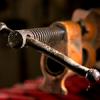I read a blog post by Joshua Kline extolling the virtues of hide glue today. I use PVA glue 99.9% of the time for woodworking. The other .1% is 2-part epoxy. The arguments for using hide glue to replace PVA glue are pretty convincing for my furniture building. Reversibility, sustainability, adjustability. It's non-toxic and has some attractive working properties. The reversibility would have been nice more often than I'd like to admit. I wonder what the downsides are?
Is anyone here regularly using hide glue?





 Reply With Quote
Reply With Quote









